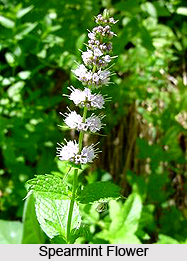 Botanical name:Mentha spicata Linn.
Botanical name:Mentha spicata Linn.
Mentha viridis Linn.
Family name:Labiatae.
Indian names are as follows:
Hindi:Pahari Pudina
Bengali:Pudina
Gujarati:Pudino
Punjabi:Pahari Pudina, Pudinakuhi
Meitei:Nugsit Hidak
Sindhi:Phudina
Telugu:Pudina.
Spearmint belongs to the Mint family and is a relative of mint and peppermint discussed separately. It is in great demand both in domestic and global market. Huge quantity of spearmint oil is imported into India every year.
It is a glabrous perennial, 30 to 90 cm high, with creeping rhizomes, indigenous to the north of England, but grown all over the world. It is cultivated in Indian gardens in the plains.
Leaves smooth or nearly so, sessile, lanceolate to ovate, acute coarsely dentate, smooth above, glandular below; flowers lilac, in loose, cylindrical, slender, interrupted spikes. The leaves have a characteristic, aromatic odor and slightly pungent taste, not followed by a cooling sensation as in the case of peppermint.
Analysis of fresh spearmint leaves gave the following values:
Moisture:83.0%
Protein:4.8%
Fat:0.6%
Carbohydrates:8.0%
Fiber:2.0%
Ash:1.6%
Calcium:200 mg/100 gram
Phosphorus:80 mg/100 gram
Iron:15.6 mg/100 gram
Vitamin A (carotene):1,700 I.U./100 gram
Nicotinic acid:0.4 mg/100 gram.
The leaves also yield riboflavin, thiamine and traces of copper.
 The fresh flowering herb on steam distillation yields 0.25 to 0.50 % of a volatile oil, known as Spearmint oil. It is a colorless, yellow or greenish yellow liquid with a characteristic odor and taste of spearmint; the aroma improves on ageing. The oil contains l-carvone, Carvone, alcohols such as dihydrocarveol, terpenes such as l-limonene and dipentene, and esters such as dihydrocarveol acetate. The chief constituent however is Carvone.
The fresh flowering herb on steam distillation yields 0.25 to 0.50 % of a volatile oil, known as Spearmint oil. It is a colorless, yellow or greenish yellow liquid with a characteristic odor and taste of spearmint; the aroma improves on ageing. The oil contains l-carvone, Carvone, alcohols such as dihydrocarveol, terpenes such as l-limonene and dipentene, and esters such as dihydrocarveol acetate. The chief constituent however is Carvone.
Green leaves of the plant are used for making chutney and for flavoring culinary preparations, vinegar, jellies and iced drinks. The herb has a lot of medicinal virtues. It is considered stimulant, carminative and anti-spasmodic. A smoothing drink is brewed from the leaves and an alcoholic beverage (mint julep) is prepared from them and is used as an antidote for poison. A sweetened infusion of the herb is given as a remedy for infantile troubles, vomiting in pregnancy and hysteria. The leaves are used in fevers and bronchitis.
Branded antacid and carminatives are being manufactured in India, are now extremely popular. There are a number of such medicines gaining popularity in Indian market.
Spearmint oil is used for flavoring chewing gums, toothpastes, confectionery and pharmaceutical preparations. It is also used for flavoring sweet dishes like puddings, cakes and kheer.
Most important commercial product of the herb is volatile oil. A number of steam distillation plants have come up in India only for extraction of spearmint oil. There is also possibility of utilizing this herb for manufacture of medicinal preparations and sauces.




















